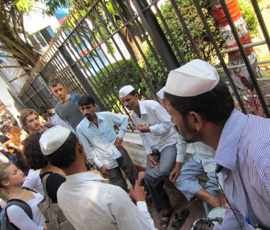
The Dabbawallas (lunch delivery men) of Mumbai
The Global South fieldtrip was designed to expose the students, to the stark contrasts that characterise Mumbai from the growth of the city’s urban middle classes, and new patterns of consumption to high-end real estate and the informal economies of the slums.
The term Global South relates to the nations of Africa, Central and Latin America and most of Asia and the QM students were encouraged to challenge current perceptions that position the Global South as a collection of places is in need of external (Northern) development interventions.
During the trip students visited sites such as the world’s largest flea markets in Chor Bazaar; MNC banks in the commercial hubs of the Bandra Kurla Complex; the laundry men at Dhobi Ghat - a vast open-air laundromat; the Dabbawallas (lunch delivery men) around Mumbai Central Station and a visit to one of the largest slums in Asia, Dharavi.
One student Nadine Clokey said: “After experiencing Mumbai first hand, you get a real sense that something is happening here. Amidst the organised chaos emerges a city that each day demonstrates resilience, initiative and entrepreneurship. Seeing and learning about Mumbai through a geographical perspective challenged my views of a city that is simply defined by its extremes in wealth.”
Fellow student Tom Voice added: “An eye-opening field-class that allowed me to see the real Global South and the diversity that exists in present day India. It has changed my perspective in relation to development and economic geography.”
Queen Mary’s School of Geography is unique to most others in the UK because it has developed a hybrid economic-development approach to its teaching unlike other universities which tend to offer the two disciplines of ‘economic geography’ and ‘development geography’ separately.